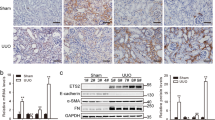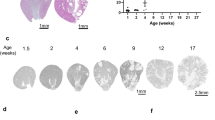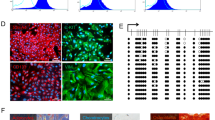Abstract
P63, a p53 family member, is expressed as TA and ΔN isoforms. Interestingly, both TAp63 and ΔNp63 are transcription factors, and regulate both common and distinct sets of target genes. p63 is required for survival of some epithelial cell lineages, and lack of p63 leads to loss of epidermis and other epithelia in humans and mice. Here, we explored the role of p63 isoforms in cell proliferation, migration and tubulogenesis by using Madin–Darby Canine Kidney (MDCK) tubular epithelial cells in two- or three-dimensional (2-D or 3-D) culture. We found that like downregulation of p53, downregulation of p63 and TAp63 decreases expression of growth-suppressing genes, including p21, PUMA and MIC-1, and consequently promotes cell proliferation and migration in 2-D culture. However, in 3-D culture, downregulation of p63, especially TAp63, but not p53, decapacitates MDCK cells to form a cyst structure through enhanced epithelial-to-mesenchymal transition (EMT). In contrast, downregulation of ΔNp63 inhibits MDCK cell proliferation and migration in 2-D culture, and delays but does not block MDCK cell cyst formation and tubulogenesis in 3-D culture. Consistent with this, downregulation of ΔNp63 markedly upregulates growth-suppressing genes, including p21, PUMA and MIC-1. Taken together, these data suggest that TAp63 is the major isoform required for tubulogenesis by maintaining an appropriate level of EMT, whereas ΔNp63 fine-tunes the rate of cyst formation and tubulogenesis by maintaining an appropriate expression level of genes involved in cell cycle arrest and apoptosis.
This is a preview of subscription content, access via your institution
Access options
Subscribe to this journal
Receive 50 print issues and online access
$259.00 per year
only $5.18 per issue
Buy this article
- Purchase on Springer Link
- Instant access to full article PDF
Prices may be subject to local taxes which are calculated during checkout





Similar content being viewed by others

References
Osada M, Ohba M, Kawahara C, Ishioka C, Kanamaru R, Katoh I et al. Cloning and functional analysis of human p51, which structurally and functionally resembles p53. Nat Med 1998; 4: 839–843.
Yang A, Kaghad M, Wang Y, Gillett E, Fleming MD, Dotsch V et al. p63, a p53 homolog at 3q27-29, encodes multiple products with transactivating, death-inducing, and dominant-negative activities. Mol Cell 1998; 2: 305–316.
Vanbokhoven H, Melino G, Candi E, Declercq W . p63, a story of mice and men. J Invest Dermatol 2011; 131: 1196–1207.
Dohn M, Zhang S, Chen X . p63alpha and DeltaNp63alpha can induce cell cycle arrest and apoptosis and differentially regulate p53 target genes. Oncogene 2001; 20: 3193–3205.
Westfall MD, Mays DJ, Sniezek JC, Pietenpol JA . The Delta Np63 alpha phosphoprotein binds the p21 and 14-3-3 sigma promoters in vivo and has transcriptional repressor activity that is reduced by Hay-Wells syndrome-derived mutations. Mol Cell Biol 2003; 23: 2264–2276.
Sasaki Y, Ishida S, Morimoto I, Yamashita T, Kojima T, Kihara C et al. The p53 family member genes are involved in the Notch signal pathway. J Biol Chem 2002; 277: 719–724.
Lo Iacono M, Di Costanzo A, Calogero RA, Mansueto G, Saviozzi S, Crispi S et al. The Hay Wells syndrome-derived TAp63alphaQ540L mutant has impaired transcriptional and cell growth regulatory activity. Cell Cycle 2006; 5: 78–87.
Park BJ, Lee SJ, Kim JI, Lee CH, Chang SG, Park JH et al. Frequent alteration of p63 expression in human primary bladder carcinomas. Cancer Res 2000; 60: 3370–3374.
Sniezek JC, Matheny KE, Westfall MD, Pietenpol JA . Dominant negative p63 isoform expression in head and neck squamous cell carcinoma. Laryngoscope 2004; 114: 2063–2072.
Massion PP, Taflan PM, Jamshedur Rahman SM, Yildiz P, Shyr Y, Edgerton ME et al. Significance of p63 amplification and overexpression in lung cancer development and prognosis. Cancer Res 2003; 63: 7113–7121.
Mills AA, Zheng B, Wang XJ, Vogel H, Roop DR, Bradley A . p63 is a p53 homologue required for limb and epidermal morphogenesis. Nature 1999; 398: 708–713.
Yang A, Schweitzer R, Sun D, Kaghad M, Walker N, Bronson RT et al. p63 is essential for regenerative proliferation in limb, craniofacial and epithelial development. Nature 1999; 398: 714–718.
Su X, Paris M, Gi YJ, Tsai KY, Cho MS, Lin YL et al. TAp63 prevents premature aging by promoting adult stem cell maintenance. Cell Stem Cell 2009; 5: 64–75.
Keyes WM, Wu Y, Vogel H, Guo X, Lowe SW, Mills AA . p63 deficiency activates a program of cellular senescence and leads to accelerated aging. Genes Dev 2005; 19: 1986–1999.
Bakkers J, Hild M, Kramer C, Furutani-Seiki M, Hammerschmidt M . Zebrafish DeltaNp63 is a direct target of Bmp signaling and encodes a transcriptional repressor blocking neural specification in the ventral ectoderm. Dev Cell 2002; 2: 617–627.
Lee H, Kimelman D . A dominant-negative form of p63 is required for epidermal proliferation in zebrafish. Dev Cell 2002; 2: 607–616.
Brunner HG, Hamel BC, Bokhoven HvH . P63 gene mutations and human developmental syndromes. Am J Med Genet 2002; 112: 284–290.
Celli J, Duijf P, Hamel BC, Bamshad M, Kramer B, Smits AP et al. Heterozygous germline mutations in the p53 homolog p63 are the cause of EEC syndrome. Cell 1999; 99: 143–153.
Allen LM, Maestri MJ . Three-dimensional sonographic findings associated with ectrodactyly ectodermal dysplasia clefting syndrome. J Ultrasound Med 2008; 27: 149–154.
Rinne T, Hamel B, van Bokhoven H, Brunner HG . Pattern of p63 mutations and their phenotypes—update. Am J Med Genet 2006; 140: 1396–1406.
van Bokhoven H, Hamel BC, Bamshad M, Sangiorgi E, Gurrieri F, Duijf PH et al. p63 Gene mutations in EEC syndrome, limb-mammary syndrome, and isolated split hand-split foot malformation suggest a genotype-phenotype correlation. Am J Hum Genet 2001; 69: 481–492.
Lindsay J, McDade SS, Pickard A, McCloskey KD, McCance DJ . Role of DeltaNp63gamma in epithelial to mesenchymal transition. J Biol Chem 2011; 286: 3915–3924.
Zhang Y, Yan W, Chen X . Mutant p53 disrupts MCF-10A cell polarity in three-dimensional culture via epithelial-to-mesenchymal transitions. J Biol Chem 2011; 286: 16218–16228.
Simons K, Fuller SD . Cell surface polarity in epithelia. Annu Rev Cell Biol 1985; 1: 243–288.
Leighton J, Estes LW, Mansukhani S, Brada Z . A cell line derived from normal dog kidney (MDCK) exhibiting qualities of papillary adenocarcinoma and of renal tubular epithelium. Cancer 1970; 26: 1022–1028.
McAteer JA, Evan AP, Gardner KD . Morphogenetic clonal growth of kidney epithelial cell line MDCK. Anat Rec 1987; 217: 229–239.
Montesano R, Schaller G, Orci L . Induction of epithelial tubular morphogenesis in vitro by fibroblast-derived soluble factors. Cell 1991; 66: 697–711.
Saxen L, Sariola H . Early organogenesis of the kidney. Pediatr Nephrol 1987; 1: 385–392.
Zhang J, Chen X, Kent MS, Rodriguez CO . Establishment of a dog model for the p53 family pathway and identification of a novel isoform of p21 cyclin-dependent kinase inhibitor. Mol Cancer Res 2009; 7: 67–78.
Zeisberg M, Neilson EG . Biomarkers for epithelial-mesenchymal transitions. J Clin Invest 2009; 119: 1429–1437.
Carroll DK, Carroll JS, Leong CO, Cheng F, Brown M, Mills AA et al. p63 regulates an adhesion programme and cell survival in epithelial cells. Nat Cell Biol 2006; 8: 551–561.
Zheng Z, Zhu H, Wan Q, Liu J, Xiao Z, Siderovski DP et al. LGN regulates mitotic spindle orientation during epithelial morphogenesis. J Cell Biol 2010; 189: 275–288.
Prindull G, Zipori D . Environmental guidance of normal and tumor cell plasticity: epithelial mesenchymal transitions as a paradigm. Blood 2004; 103: 2892–2899.
Kim D, Dressler GR . Nephrogenic factors promote differentiation of mouse embryonic stem cells into renal epithelia. J Am Soc Nephrol 2005; 16: 3527–3534.
Jia L, Liu F, Hansen SH, Ter Beest MB, Zegers MM . Distinct roles of cadherin-6 and E-cadherin in tubulogenesis and lumen formation. Mol Biol Cell 2011; 22: 2031–2041.
Tan M, Wang Y, Guan K, Y Sun . PTGF-beta, a type beta transforming growth factor (TGF-beta) superfamily member, is a p53 target gene that inhibits tumor cell growth via TGF-beta signaling pathway. Proc Natl Acad Sci USA 2000; 97: 109–114.
Lipschutz JH, Guo W, O'Brien LE, Nguyen YH, Novick P, Mostov KE . Exocyst is involved in cystogenesis and tubulogenesis and acts by modulating synthesis and delivery of basolateral plasma membrane and secretory proteins. Mol Biol Cell 2000; 11: 4259–4275.
Dressler G . Tubulogenesis in the developing mammalian kidney. Trends Cell Biol 2002; 12: 390–395.
Guo X, Keyes WM, Papazoglu C, Zuber J, Li W, Lowe SW et al. TAp63 induces senescence and suppresses tumorigenesis in vivo. Nat Cell Biol 2009; 11: 1451–1457.
Su X, Chakravarti D, Cho MS, Liu L, Gi YJ, Lin YL et al. TAp63 suppresses metastasis through coordinate regulation of Dicer and miRNAs. Nature 2010; 467: 986–990.
Zeisberg M, Shah AA, Kalluri R . Bone morphogenic protein-7 induces mesenchymal to epithelial transition in adult renal fibroblasts and facilitates regeneration of injured kidney. J Biol Chem 2005; 280: 8094–8100.
Thiery JP, Acloque H, Huang RY, Nieto MA . Epithelial-mesenchymal transitions in development and disease. Cell 2009; 139: 871–890.
Cook HT . The origin of renal fibroblasts and progression of kidney disease. Am J Pathol 2010; 176: 22–24.
Peinado H, Olmeda D, A Cano . Snail, Zeb and bHLH factors in tumour progression: an alliance against the epithelial phenotype? Nat Revi Cancer 2007; 7: 415–428.
Ihrie RA, Marques MR, Nguyen BT, Horner JS, Papazoglu C, Bronson RT et al. Perp is a p63-regulated gene essential for epithelial integrity. Cell 2005; 120: 843–856.
Adorno M, Cordenonsi M, Montagner M, Dupont S, Wong C, Hann B et al. A Mutant-p53/Smad complex opposes p63 to empower TGFbeta-induced metastasis. Cell 2009; 137: 87–98.
Park SM, Gaur AB, Lengyel E, Peter ME . The miR-200 family determines the epithelial phenotype of cancer cells by targeting the E-cadherin repressors ZEB1 and ZEB2. Genes Dev 2008; 22: 894–907.
Tucci P, Agostini M, Grespi F, Markert EK, Terrinoni A, Vousden KH et al. Loss of p63 and its microRNA-205 target results in enhanced cell migration and metastasis in prostate cancer. Proc Natl Acad Sci USA 2012; 109: 15312–15317.
Gregory PA, Bert AG, Paterson EL, Barry SC, Tsykin A, Farshid G et al. The miR-200 family and miR-205 regulate epithelial to mesenchymal transition by targeting ZEB1 and SIP1. Nat Cell Biol 2008; 10: 593–601.
Herfs M, Hubert P, Suarez-Carmona M, Reschner A, Saussez S, Berx G et al. Regulation of p63 isoforms by snail and slug transcription factors in human squamous cell carcinoma. Am J Pathol 2010; 176: 1941–1949.
O'Brien LE, Tang K, Kats ES, Schutz-Geschwender A, Lipschutz JH, KE Mostov . ERK and MMPs sequentially regulate distinct stages of epithelial tubule development. Dev Cell 2004; 7: 21–32.
Pollack AL, Runyan RB, Mostov KE . Morphogenetic mechanisms of epithelial tubulogenesis: MDCK cell polarity is transiently rearranged without loss of cell-cell contact during scatter factor/hepatocyte growth factor-induced tubulogenesis. Dev Biol 1998; 204: 64–79.
Cao Y, Wang L, Nandy D, Zhang Y, Basu A, Radisky D et al. Neuropilin-1 upholds dedifferentiation and propagation phenotypes of renal cell carcinoma cells by activating Akt and sonic hedgehog axes. Cancer Res 2008; 68: 8667–8672.
Zimmers TA, Jin X, Hsiao EC, McGrath SA, Esquela AF, Koniaris LG . Growth differentiation factor-15/macrophage inhibitory cytokine-1 induction after kidney and lung injury. Shock 2005; 23: 543–548.
O'Brien LE, Yu W, Tang K, Jou TS, Zegers MM, Mostov KE . Morphological and biochemical analysis of Rac1 in three-dimensional epithelial cell cultures. Methods Enzymol 2006; 406: 676–691.
Liu G, Chen X . DNA polymerase eta, the product of the xeroderma pigmentosum variant gene and a target of p53, modulates the DNA damage checkpoint and p53 activation. Mol Cell Biol 2006; 26: 1398–1413.
Sensen CW, Charlebois RL, Chow C, Clausen IG, Curtis B, Doolittle WF et al. Completing the sequence of the Sulfolobus solfataricus P2 genome. Extremophiles 1998; 2: 305–312.
Zhang Y, Shu L, Chen X . Syntaxin 6, a regulator of the protein trafficking machinery and a target of the p53 family, is required for cell adhesion and survival. J Biol Chem 2008; 283: 30689–30698.
Acknowledgements
This work was supported in part by the National Institutes of Health grants CA102188, CA108122 and CA076069. We thank Jin Zhang for helpful comments on this manuscript.
Author Contributions
Y Zhang and W Yan did the experiments and analyzed the data; X Chen supervised the project and analyzed the data; and Y Zhang, W Yan and X Chen wrote the paper. All authors read and commented on the draft versions of the manuscript and approved the final version.
Author information
Authors and Affiliations
Corresponding author
Ethics declarations
Competing interests
The authors declare no conflict of interest.
Additional information
Supplementary Information accompanies this paper on the Oncogene website
Rights and permissions
About this article
Cite this article
Zhang, Y., Yan, W. & Chen, X. P63 regulates tubular formation via epithelial-to-mesenchymal transition. Oncogene 33, 1548–1557 (2014). https://doi.org/10.1038/onc.2013.101
Received:
Revised:
Accepted:
Published:
Issue Date:
DOI: https://doi.org/10.1038/onc.2013.101
Keywords
This article is cited by
-
E47 upregulates ΔNp63α to promote growth of squamous cell carcinoma
Cell Death & Disease (2021)
-
TAp63 suppress metastasis via miR-133b in colon cancer cells
British Journal of Cancer (2014)


